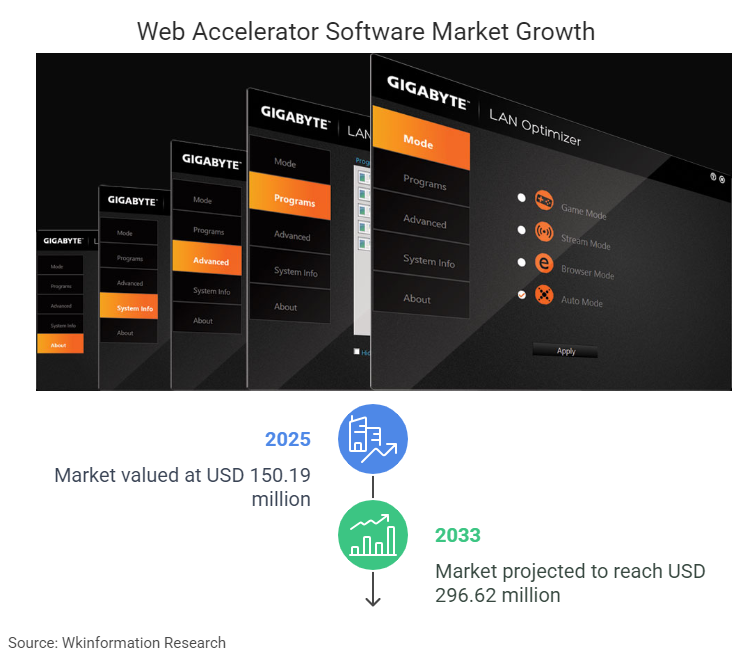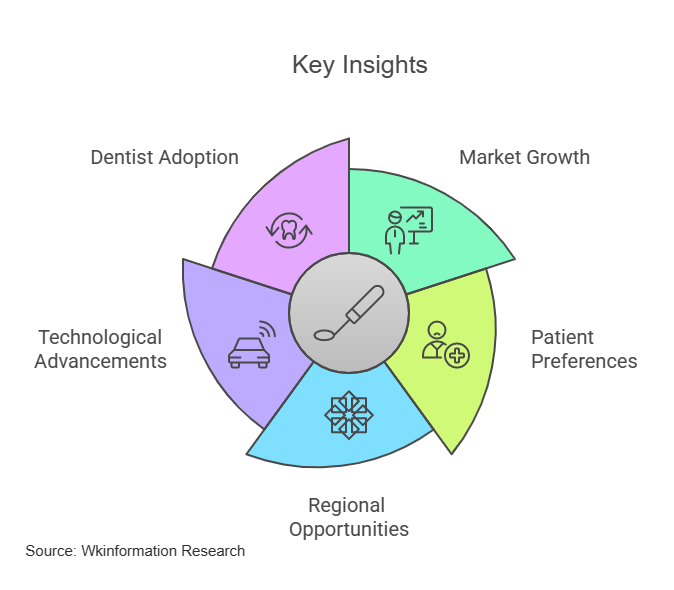
Web accelerator software plays a pivotal role in optimizing digital performance by reducing latency and enhancing content delivery. The Web Accelerator Software Market, valued at USD 150.19 million in 2025, is projected to reach USD 296.62 million by 2033, growing at a 8.88% CAGR. Emerging software development trends, such as AI integration and edge computing, have revolutionized this market. The shift toward cloud-based solutions and mobile-first strategies has further amplified demand. As businesses embrace digital transformation, staying ahead in this evolving landscape becomes essential for maintaining competitive advantage.
Key Insights
- Web accelerator software makes websites faster by cutting load times. It also uses resources better, making users happier and more engaged.
- The web accelerator market is growing quickly. It may reach USD 296.62 million by 2033 because of AI and cloud-based tools.
- Companies can improve their online presence with cloud-based accelerators. These tools are flexible and grow easily without big costs.
- New tech like edge computing and 5G is changing web speed. They help process data faster and make apps work better for users.
- Security is now a key part of web accelerator software. It helps businesses keep websites fast, safe, and protect important data

Overview of the Web Accelerator Software Market
Definition and Purpose
Web accelerator software enhances website performance by reducing load times and optimizing resource usage. It achieves this through techniques like caching, data compression, and content delivery optimization. Businesses benefit from faster websites, which improve user satisfaction and engagement. Additionally, these tools reduce bandwidth costs by optimizing server resources, making them a cost-effective solution. Companies also experience increased conversion rates and better SEO rankings due to improved page speed.
Market Growth Drivers
Several factors drive the growth of the web accelerator software market:
- Technological advancements in AI, automation, and IoT improve operational efficiency.
- Rising investments in emerging markets boost demand for advanced solutions.
- The rapid adoption of digital transformation strategies enhances market reach and efficiency.
- Increasing demand for sustainability and eco-friendly solutions contributes to market popularity.
Product Segmentation Analysis
By Type
Cloud-based Web Accelerator
Cloud-based web accelerators are hosted in the cloud, offering scalability, centralized management, and remote access. They optimize content delivery by caching data and routing it through distributed servers, improving website speed and reducing latency. This type is cost-effective, flexible, and easily upgradable, making it ideal for businesses seeking to scale quickly and reach global audiences. However, its reliance on internet connectivity and potential security concerns are important considerations.
On-premises Web Accelerator
On-premises web accelerators are installed locally within a company’s infrastructure, giving businesses full control over their performance and security. These solutions are preferred by organizations with strict data privacy or compliance requirements. While they offer better security and reliability, on-premises accelerators come with higher upfront costs, ongoing maintenance, and limited scalability compared to cloud-based alternatives.
By Application
Web accelerator software serves various industries, including e-commerce, media, and education. E-commerce platforms rely on these tools to ensure seamless user experiences during high-traffic periods. Media companies use them to deliver high-quality streaming services, while educational institutions benefit from faster access to online resources.
By Region
The market exhibits significant regional variation. North America leads due to high digital transformation adoption rates. Europe follows, driven by stringent data protection regulations. The Asia-Pacific region shows rapid growth, fueled by increasing internet penetration and investments in digital infrastructure.
Key Trends Shaping the Web Accelerator Software Market

AI-Assisted Development and Machine Learning Integration
AI-assisted development has become a cornerstone of modern web accelerator software. AI-driven algorithms analyze user behavior and traffic patterns in real-time, enabling dynamic optimization of resources. This allows websites to adapt to fluctuating demands, ensuring seamless user experiences during traffic spikes. By integrating artificial intelligence and machine learning, businesses can leverage next-gen tools for software development to enhance operational efficiency. These ai-based solutions not only improve website performance but also reduce costs by optimizing resource allocation.
AI integration also supports sustainable software engineering by minimizing energy consumption through intelligent load balancing. As emerging technology trends continue to evolve, the role of ai in web acceleration will expand, offering innovative solutions for real-time data processing and adaptive networks.
The Shift Toward Cloud-Based Solutions
The shift toward cloud-based solutions has revolutionized the web accelerator software market. Cloud-based web accelerators provide scalability, flexibility, and lower initial costs, making them an attractive option for businesses of all sizes. Organizations can quickly adjust their web acceleration capabilities to meet changing demands without investing heavily in infrastructure. These solutions also include redundancy and failover features, enhancing reliability and performance.
The increasing adoption of cloud computing has driven demand for cloud-based web accelerators. These tools are essential for managing higher traffic volumes and ensuring optimal website performance. As tech trends continue to shape the industry, cloud-based solutions will remain a critical component of sustainable software engineering.
Emerging Technology Trends in Edge Computing
Emerging technology trends in edge computing are transforming the development of web accelerator software. By processing data closer to users, edge computing significantly reduces latency and improves response times. This is particularly beneficial for applications requiring real-time data processing, such as gaming and e-commerce.
Edge computing also supports sustainable software engineering by reducing the need for extensive data transmission across centralized networks. As businesses adopt these tech trends, edge computing will play a pivotal role in delivering next-gen tools for software development. Its integration with ai-based solutions will further enhance the capabilities of web accelerator software, ensuring faster and more efficient applications.
Cybersecurity as a Core Component of Web Acceleration
Cybersecurity has become a fundamental aspect of web accelerator software. As cyber threats grow more sophisticated, businesses must prioritize secure web acceleration to protect sensitive data and maintain user trust. Modern web accelerators incorporate advanced security features, such as encryption protocols and real-time threat detection, to safeguard digital assets. These tools not only enhance website performance but also mitigate risks associated with data breaches and cyberattacks.
The integration of cybersecurity into web acceleration ensures that businesses can deliver fast and secure online experiences. For instance, web accelerators now include Distributed Denial of Service (DDoS) protection to prevent service disruptions during high-traffic periods. Additionally, secure socket layer (SSL) optimization accelerates encrypted traffic without compromising security. By embedding these features, companies can address the dual challenge of performance and protection.
The growing reliance on digital platforms has amplified the impact of cybersecurity on web acceleration. Organizations that fail to adopt secure solutions risk losing customer confidence and facing regulatory penalties. As a result, cybersecurity has transitioned from being an optional feature to a core component of web accelerator software.
The Role of IoT and 5G in Market Evolution
The Internet of Things (IoT) and 5G technologies are reshaping the web accelerator software market. These advancements enable faster data transmission and improved connectivity, optimizing user experiences across various applications. Businesses can leverage these technologies to meet the increasing demand for high-speed internet services.
- IoT devices generate vast amounts of data, requiring efficient processing and delivery. Web accelerators equipped with IoT capabilities ensure seamless communication between devices and networks.
- 5G technology enhances the performance of web accelerators by reducing latency and increasing bandwidth. This allows businesses to deliver real-time services, such as video streaming and online gaming, with minimal delays.
- The combination of IoT and 5G supports the development of smart cities and connected ecosystems, further driving the demand for advanced web acceleration solutions.
The impact of IoT and 5G extends beyond performance improvements. These technologies enable businesses to innovate and expand into new markets. For example, industries such as healthcare and manufacturing benefit from faster and more reliable data exchange, enhancing operational efficiency. As IoT and 5G adoption grows, their influence on the web accelerator software market will continue to expand.
Market Share Analysis
Major Players in the Web Accelerator Software Market
Overview of Leading Companies
- NGINX, Inc
- Squid-Cache
- Lighttpd
- Ncache
- Azure SignalR Service
- WP Rocket
- Varnish
- Apachebooster
- Caddy
- Cherokee
Market Share Distribution
The market share distribution reflects the dominance of these key players. Akamai Technologies leads with a significant share due to its robust content delivery network and extensive client base. Cloudflare follows closely, leveraging its global reach and innovative optimization tools. Fastly, with its focus on edge computing, has carved out a niche in real-time application performance.
Competitive Landscape
Strategies Driving Market Leadership
Major players employ diverse strategies to maintain their competitive edge. These include:
- Technological Advancements: Investing in new technologies to enhance performance.
- Innovation: Continuously developing features to meet evolving demands.
- Cost Competitiveness: Offering attractive pricing models to expand customer bases.
- Product Innovation: Improving existing products and introducing new ones.
- Geographical Reach: Expanding operations into emerging regions to capture untapped markets.
- Partnerships: Forming alliances to strengthen capabilities and market presence.
These strategies enable companies to adapt to changing market dynamics and sustain growth.
Recent Mergers, Acquisitions, and Partnerships
Strategic investments in mergers, acquisitions, and partnerships have reshaped the competitive landscape. Companies actively pursue these initiatives to enhance their geographic reach and technological capabilities. For example, partnerships with cloud service providers have allowed firms to integrate cloud-based solutions seamlessly. Additionally, acquisitions of smaller tech firms have bolstered innovation pipelines, enabling faster development of advanced features.
The rising demand for mobile optimization and cybersecurity has further driven collaboration among industry leaders. These efforts ensure that companies remain agile and responsive to customer needs while solidifying their positions in the market.
Industry Challenges and Opportunities
Challenges in the Web Accelerator Software Market
High Costs of Implementation
High implementation costs remain a significant barrier for businesses adopting web accelerator software. Small and medium-sized enterprises (SMEs) often struggle with the substantial initial investment required. Additionally, ongoing maintenance expenses further deter adoption in price-sensitive regions.
| Key Challenge | Description |
|---|---|
| High Initial Investment | Significant capital investment required for adoption deters potential buyers, especially SMEs. |
| Ongoing Maintenance Costs | Continuous costs associated with maintenance reduce accessibility in many regions. |
These financial hurdles limit the accessibility of web acceleration solutions, particularly for businesses operating on tight budgets.
Integration with Legacy Systems
Integrating web accelerator software with existing IT infrastructure poses another challenge. Many companies rely on legacy systems that are incompatible with modern acceleration technologies. This integration process is often resource-intensive and time-consuming.
Other obstacles include:
- Managing dynamic content and real-time interactions.
- Ensuring compatibility across diverse platforms and technologies.
- Addressing security concerns related to data protection.
These issues complicate the adoption process, requiring businesses to allocate additional resources for successful implementation.
Opportunities for Growth
Expansion in Emerging Markets
Emerging markets present immense growth opportunities for web accelerator software. The increasing adoption of edge computing allows businesses to process data closer to users, improving speed and efficiency. This is particularly beneficial for organizations aiming to enhance digital experiences.
The surge in smartphone usage further drives demand for mobile optimization. Web acceleration technologies that optimize content delivery for mobile devices are becoming essential in these regions. Companies investing in these markets can capitalize on the growing need for advanced digital solutions.
Increasing Demand from E-Commerce and Digital Services
The rise of e-commerce continues to fuel demand for web accelerator software. These tools optimize website performance during high-traffic periods, ensuring seamless user experiences. Fast-loading pages reduce bounce rates and improve customer satisfaction.
Key drivers include:
- Enhanced performance for e-commerce platforms during peak shopping seasons.
- Improved page load times, leading to higher conversion rates.
- Responsiveness under heavy traffic, critical for maintaining operational efficiency.
As digital services expand, businesses increasingly rely on web acceleration to meet customer expectations and drive growth.
Future Outlook for 2025 and Beyond

Predicted Market Growth and Revenue Trends
The web accelerator software market is poised for significant growth in the coming years. Analysts project the market to grow from US$ 150.19 million in 2025 to US$ 296.62 million by 2033, reflecting a robust CAGR of 8.88% during the forecast period. Several factors contribute to this upward trajectory:
- Increasing demand for faster web performance and enhanced user experiences.
- Rising adoption of cloud-based solutions across industries.
- The proliferation of e-commerce platforms requiring seamless digital operations.
- Growing reliance on web applications for business and consumer needs.
This growth underscores the transformative role of web accelerator software in the digital economy. Businesses investing in these technologies can expect to capitalize on the expanding market opportunities.
The Impact of Emerging Technologies on the Market
Emerging technologies such as cloud computing, edge computing, and artificial intelligence are reshaping the web accelerator software landscape. Cloud computing, in particular, has become a cornerstone for scalability and flexibility. Companies leveraging cloud-based solutions can adapt quickly to fluctuating demands, ensuring uninterrupted service delivery.
Edge computing further enhances performance by processing data closer to users, reducing latency. This technology is especially beneficial for applications requiring real-time responsiveness, such as online gaming and video streaming. Artificial intelligence adds another layer of innovation by enabling dynamic optimization and predictive analytics, which improve operational efficiency.
These advancements not only enhance the capabilities of web accelerator software but also drive its adoption across diverse sectors. As businesses embrace these technologies, they position themselves to meet the evolving demands of the digital-first economy.
Adapting to Evolving Customer Expectations
Meeting customer expectations requires businesses to adopt a proactive approach. Companies are increasingly focusing on providing seamless experiences across all platforms, including mobile and desktop. Investments in mobile-friendly web acceleration technologies have become a priority, given the surge in smartphone usage.
To stay competitive, businesses must also consider market trends and consumer preferences. Understanding regional dynamics and regulatory environments is crucial for tailoring solutions to specific markets. Strategic investments in research and development, along with partnerships and acquisitions, further enable companies to expand their geographic reach and enhance their offerings.
By aligning their strategies with customer needs, businesses can foster loyalty and drive long-term growth. The ability to adapt to these expectations will determine market leaders in the years ahead.
Overview
Web accelerator software continues to play a vital role in the digital-first economy, enabling businesses to deliver faster and more reliable online experiences. The market’s evolution highlights several key trends and challenges:
- Key Trends:
- Automation and artificial intelligence drive innovation.
- Mobile optimization remains a top priority.
- Cloud-based solutions dominate due to scalability and cost-efficiency.
- Challenges:
- Regulatory hurdles complicate market entry.
- Supply chain disruptions impact deployment timelines.
- Differentiation becomes critical in a competitive landscape.
Looking ahead, businesses must embrace emerging technologies to remain competitive. Prioritizing mobile optimization, integrating artificial intelligence, and enhancing cybersecurity will ensure sustained growth. Companies that adapt to these trends and focus on personalization will thrive in the dynamic web accelerator software market by 2025 and beyond.
| Report Metric | Details |
|---|---|
| Report Name | Global Web Accelerator Software Market Report |
| Base Year | 2024 |
| Segment by Type | · Cloud-based
· On-premises |
| Segment by Application | · e-Commerce
· Media · Education |
| Geographies Covered | · North America (United States, Canada)
· Europe (Germany, France, UK, Italy, Russia) · Asia-Pacific (China, Japan, South Korea, Taiwan) · Southeast Asia (India) · Latin America (Mexico, Brazil) |
| Forecast units | USD million in value |
| Report coverage | Revenue and volume forecast, company share, competitive landscape, growth factors and trends |
FAQ
What is web accelerator software, and why is it important?
Web accelerator software optimizes website performance by reducing load times and enhancing resource efficiency. It improves user experience, boosts SEO rankings, and reduces bandwidth costs. Businesses rely on these tools to ensure faster, more reliable digital interactions, especially during high-traffic periods.
How does AI enhance web accelerator software?
AI enables real-time traffic analysis and dynamic resource optimization. It helps websites adapt to fluctuating demands, ensuring seamless performance. AI-driven tools also reduce energy consumption through intelligent load balancing, making web acceleration more efficient and sustainable.
What industries benefit most from web accelerator software?
E-commerce, media, and education sectors gain the most from web accelerator software. E-commerce platforms ensure smooth user experiences during peak traffic. Media companies deliver high-quality streaming, while educational institutions provide faster access to online resources.
Why are cloud-based solutions gaining popularity in this market?
Cloud-based solutions offer scalability, flexibility, and cost-efficiency. Businesses can adjust web acceleration capabilities without significant infrastructure investments. These solutions also enhance reliability through redundancy and failover features, making them ideal for managing high traffic volumes.
What role do IoT and 5G play in web acceleration?
IoT and 5G technologies improve connectivity and data transmission speeds. IoT devices generate vast data volumes, requiring efficient processing. 5G reduces latency and increases bandwidth, enabling real-time services like gaming and streaming. Together, they drive innovation in web accelerator software.
Global Web Accelerator Software Market Report – Table of Contents
1 Market Study Overview
2 Basic Product Information
3 Market Analysis
4 Web Accelerator Software Related Market Analysis
5 Global Trend Summary
6 Competition by Manufacturer
7 Analysis of Key Players
8 Global Web Accelerator Software Revenue, Sales Categorized by Regions
9 North America Web Accelerator Software Market Size Categorized by Countries
10 Europe Web Accelerator Software Market Size Categorized by Countries
11 Asia-pacific Web Accelerator Software Market Size Categorized by Countries
12 South America Web Accelerator Software Market Size Categorized by Countries
13 Middle East and Africa Web Accelerator Software Market Size Categorized by Countries
14 Global Web Accelerator Software Industry Segment Analysis
15 Global Web Accelerator Software Market Forecast
16 Research Findings and Conclusion
17 Appendix


